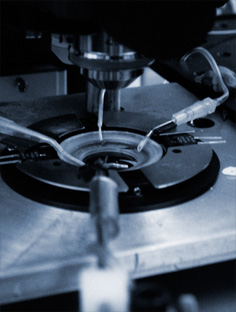Research
The potent nervous system effects of nicotine are clearly evidenced by the widespread use of tobacco products. In addition to reinforcing smoking behavior, nicotine is also reported to have analgesic, anxiolytic and memory-enhancing properties. Many CNS neurons express membrane receptors that bind nicotine with high affinity, and these receptors are ultimately responsible for the behavioral effects of nicotine. The normal activator of these receptors is the neurotransmitter acetylcholine, and there are several nicotinic acetylcholine receptors (nAChR) subtypes expressed in the CNS. Determination of the nAChR subtypes that underlie the various physiological effects of nicotine may lead to the identification of new methods for treating neurological disorders, in addition to the obvious benefit of potentially helping people quit smoking.
The focus of research in the McGehee Lab is the functional role of neuronal nAChRs, under normal conditions and when exposed to applied nicotine. An interesting, but confounding problem in the field is that although nAChRs are expressed throughout the brain and spinal cord, there is very little direct evidence that they mediate synaptic transmission. That is, there are relatively few synapses where acetylcholine release from the presynaptic cell has been shown to activate nicotinic receptors on the postsynaptic cell. Our research, along with that from several other groups, has shown that nicotinic receptors can act by a presynaptic mechanism to influence the release of other neurotransmitters. The combined evidence indicates that a predominant role of nAChRs is to modify rather than mediate synaptic transmission.
We are investigating the cellular mechanisms underlying two important physiological effects of nicotine. The first is the reinforcing or addictive properties of nicotine. All drugs of abuse are known to enhance dopamine release from midbrain reward centers and this is a crucial step in the reinforcement of drug-taking behavior. We have found that, similar to the role of these receptors in other CNS regions, presynaptic nAChRs can enhance excitatory inputs to midbrain dopamine neurons. A long standing question in the field is how a single nicotine exposure can induce increases in dopamine release that last for hours, while the nicotinic receptors undergo desensitization in seconds. Our results indicate that presynaptic nAChR activation can contribute to the induction of long-term potentiation (LTP) of excitatory transmission at this synapse. LTP is believed to be an important step in memory formation in other brain regions. The idea that nicotine can induce a 'memory trace' within the reward center may explain why this substance is such a strong motivator.
The second main research focus is nAChR-mediated modulation of pain signaling in spinal cord and higher centers. A notable effect of nicotine, reported even by the earliest users of tobacco, is relief of pain. To investigate the underlying mechanisms, we are examining the functional properties and molecular components of nAChRs expressed by neurons within sensory transduction pathways. These experiments involve recording the physiological responses from neurons in spinal cord and brain stem slices that contain descending pain control pathways. In both preparations, there is clear evidence that neurons in these areas express nAChRs. In addition, nAChRs modify synaptic plasticity contributing to persistent changes in excitatory drive. These studies will continue to provide insights into the role of nAChRs in pain signaling, and may help identify new means of treating chronic pain conditions.







